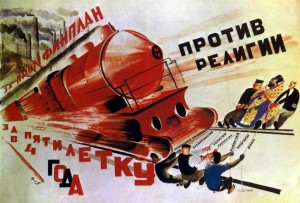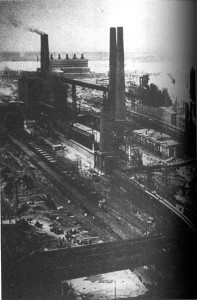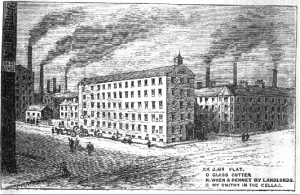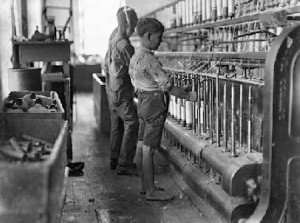
“For the Industrial Plan; for completing a five-year plan in only four” Yurij Pimenov, 1930 (source)
The construction of the Magnetostroi, an envisioned beacon of industrial prowess and microcosm of the idealized egalitarian society, was an enormous undertaking by the Soviet government in the 1930s that engendered massive paradigmatic shifts in demographics, economics, and the relationship between central authority and the proletarian masses. The frequently irrational ambition of the Bolshevik government sparked a variety of obstacles that were often met with rather paradoxical schemes in an attempt to rapidly and efficiently allocate human resources. In his essay entitled Peopling Magnitostroi, Stephen Kotkin illustrates how the rise of construction centers in the untamed Siberian steppe encompassed the drive for collectivization, rapid economic development, and proletarianization that so permeated Stalin’s first Five Year plan.
Kotkin begins by discussing the first step undertaken in order to propel this tremendous project upon its course: the idea of mobilization, a key element integral to the mindset of the Bolsheviks in authority. However, due to the high demand for workers and the refusal of many to leave their posts to embark on a fantastical quest to the unforgiving Siberian wilderness, the central authority executed a process laced with sensationalist propaganda often bordering on fanaticism known as recruitment (orgnabor) ((Stephen Kotkin, “Peopling Magnitostroi,” in Magnetic Mountain: Stalinism as a Civilization (Berkeley: University of California Press, 1993), 67.)) in an attempt to incentivize the peasants with raw materials in exchange for labor – essentially setting up the foundations for a pseudo-labor market. As more obstacles vindictively thwarted the site’s path to industrial nirvana, the Soviet government often resorted to more capricious and coercive methods, including the assembly of exiled kulaks and peasants caught in a vicious cycle of subjugation into human resources, rapid and fleeting economic success, greater ambitions at the central authority, and further subjugation. Nonetheless, not all of the peasant migration from the countryside to the cities was violently induced; the otkhodniki, or peasant seasonal workers, often came of their own will. It was the government’s desire, however, to make them permanent and bring a wide variety of foreigners from the outside regions into a single collective working group in the cities, leading to large-scale demographic transfigurations. ((Ibid, 72-73.))
Another pivotal argument posed by Kotkin is the idea of the social transformation, propagated by the government’s garnering of illiterate and inexperienced individuals, blank slates on which socialism could be deeply etched into via training programs at the industrial center, which had been employed to simultaneously play the role of the supreme factory of skilled proletarians and cadres that “grew like mushrooms.” ((Ibid, 76.)) The philosophy of collectivization and crushing counterrevolutionary thought also prevailed in the industry through the government’s vanquishing of peasant artels, a capitalist-esque form of hierarchy and authority. ((Ibid, 77))
An incredulous aspect of the nature of Magnitostroi’s development is the paradoxical policy decisions made by the government in attempts to combat the disorder and reluctance of the workers to perform their jobs during construction. To incentivize, the oxymoronic socialist competition was introduced, ((Ibid, 79)) and to organize, the old Tsarist passport identification system was reintroduced. This serves to illustrate how far the government was willing to go for the sake of industrial progress and efficient collective work, and how exponentially the authority of the government rose at the same time, imbuing the populace with industrial spirit. Despite the fact that the increased systemization brought along with it an onslaught of limitations and obstacles, the government was relatively successful in dictating the blueprints for a modern metallurgic civilization. Overall, the essay was quite the comprehensive dissection of Soviet industrialism and social change during the 1930s, using Magnitostroi as an example. Delving into the idea of Stalinism as the encroaching dominant political philosophy and Stalin’s involvement further than just the Five Year Plan would make for a broader discussion.




